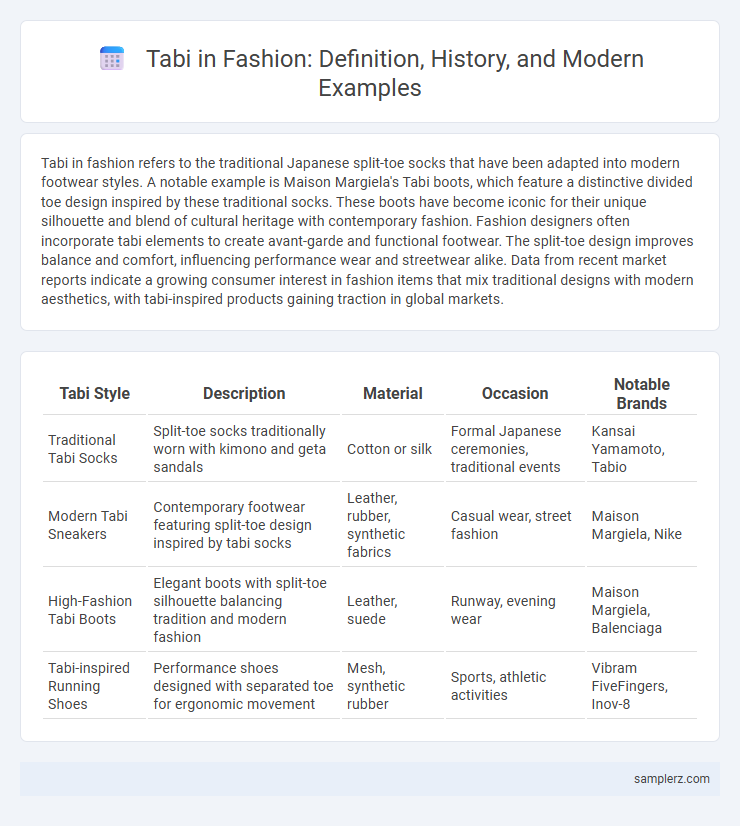Tabi in fashion refers to the traditional Japanese split-toe socks that have been adapted into modern footwear styles. A notable example is Maison Margiela's Tabi boots, which feature a distinctive divided toe design inspired by these traditional socks. These boots have become iconic for their unique silhouette and blend of cultural heritage with contemporary fashion. Fashion designers often incorporate tabi elements to create avant-garde and functional footwear. The split-toe design improves balance and comfort, influencing performance wear and streetwear alike. Data from recent market reports indicate a growing consumer interest in fashion items that mix traditional designs with modern aesthetics, with tabi-inspired products gaining traction in global markets.
Table of Comparison
| Tabi Style | Description | Material | Occasion | Notable Brands |
|---|---|---|---|---|
| Traditional Tabi Socks | Split-toe socks traditionally worn with kimono and geta sandals | Cotton or silk | Formal Japanese ceremonies, traditional events | Kansai Yamamoto, Tabio |
| Modern Tabi Sneakers | Contemporary footwear featuring split-toe design inspired by tabi socks | Leather, rubber, synthetic fabrics | Casual wear, street fashion | Maison Margiela, Nike |
| High-Fashion Tabi Boots | Elegant boots with split-toe silhouette balancing tradition and modern fashion | Leather, suede | Runway, evening wear | Maison Margiela, Balenciaga |
| Tabi-inspired Running Shoes | Performance shoes designed with separated toe for ergonomic movement | Mesh, synthetic rubber | Sports, athletic activities | Vibram FiveFingers, Inov-8 |
The Historical Origins of Tabi in Fashion
Tabi, traditional Japanese split-toe socks dating back to the 15th century Muromachi period, originally served practical purposes by allowing easier movement and wearing of sandals. These functional socks evolved into a fashion statement as designers like Maison Margiela reinterpreted the tabi silhouette into iconic split-toe footwear, blending cultural heritage with avant-garde style. This fusion highlights tabi's enduring influence on contemporary fashion, demonstrating how historical origins shape modern trends.
Iconic Designers Who Popularized Tabi Shoes
Maison Margiela is widely recognized for popularizing Tabi shoes, introducing the split-toe design as a signature element in avant-garde fashion since 1989. Japanese designer Junya Watanabe also embraced the Tabi silhouette, blending traditional aesthetics with contemporary streetwear. These iconic designers redefined footwear by merging cultural heritage with innovative craftsmanship, making Tabi shoes a symbol of modern fashion artistry.
Tabi Shoes on High Fashion Runways
Tabi shoes, originating from traditional Japanese split-toe footwear, have been prominently featured in high fashion runways by designers like Maison Margiela, known for reinterpreting the iconic split-toe silhouette with avant-garde materials and bold colors. These shoes blend cultural heritage with contemporary style, creating a distinct look that challenges conventional footwear norms. Their presence on international fashion stages highlights the fusion of innovation and tradition, influencing global fashion trends and luxury footwear collections.
Tabi-Inspired Street Style Trends
Tabi-inspired street style trends prominently feature split-toe footwear, blending traditional Japanese design with modern urban aesthetics. Popular brands incorporate tabi boots and sneakers crafted from leather and canvas, often paired with oversized layers and asymmetrical silhouettes. This fusion highlights a unique cultural heritage while influencing contemporary global street fashion, attracting fashion enthusiasts seeking bold, avant-garde looks.
How to Style Tabi Footwear for Modern Outfits
Tabi footwear, inspired by traditional Japanese split-toe socks, pairs seamlessly with contemporary fashion by balancing avant-garde aesthetics and streetwear appeal. Styling Tabi boots with tailored trousers or cropped denim enhances their unique silhouette, while monochrome outfits or layered textures highlight their bold, sculptural design. Incorporate minimalist accessories and neutral palettes to let Tabi footwear become the focal point of modern, edgy ensembles.
Tabi Boots vs. Traditional Tabi: Key Differences
Tabi boots feature a modern adaptation of the traditional Japanese split-toe design, offering a sleek silhouette with ankle-high construction ideal for contemporary fashion. Traditional tabi are ankle-length, soft, and made from cotton, primarily used as socks to be worn with sandals. The key differences lie in materials, structure, and usage: tabi boots use leather or synthetic materials with sturdy soles for outdoor wear, while traditional tabi prioritize comfort and flexibility for indoor or ceremonial use.
Celebrities Spotted Wearing Tabi Shoes
Celebrities like Rihanna and Kanye West have been frequently spotted wearing Tabi shoes, popularizing their unique split-toe design in high fashion. The shoes, originally designed by Maison Margiela, combine avant-garde aesthetics with streetwear appeal, making them a favorite among fashion-forward influencers. Tabi shoes have also appeared on red carpets and in music videos, cementing their status as an iconic statement piece in contemporary fashion culture.
Tabi Collaborations with Popular Fashion Brands
Tabi collaborations with popular fashion brands have significantly influenced contemporary streetwear and luxury fashion. Maison Margiela's iconic Tabi boots, featuring the split-toe design inspired by traditional Japanese footwear, have seen partnerships with brands like Reebok and Converse, merging avant-garde aesthetics with athletic functionality. Limited edition releases from these collaborations often highlight innovative materials and bold colorways that attract collectors and fashion enthusiasts worldwide.
The Cultural Symbolism Behind Tabi in Contemporary Fashion
Tabi footwear, characterized by its split-toe design, symbolizes a blend of tradition and modernity in contemporary fashion, reflecting Japan's rich cultural heritage. Designers integrate Tabi into avant-garde collections to evoke themes of identity, craftsmanship, and the fusion of East and West. This iconic style represents both a nod to historical roots and a statement of innovation within global fashion narratives.
Where to Shop for Tabi Footwear Today
Tabi footwear, known for its distinctive split-toe design, can be found in high-end fashion boutiques such as Maison Margiela stores, which popularized the modern interpretation of Tabi boots. Luxury department stores including Nordstrom and Saks Fifth Avenue also stock exclusive Tabi styles, catering to fashion-forward consumers. Online platforms like Farfetch, SSENSE, and MatchesFashion offer a wide selection of Tabi shoes from various designers, providing convenient access to this iconic footwear trend.

example of Tabi in fashion Infographic
 samplerz.com
samplerz.com